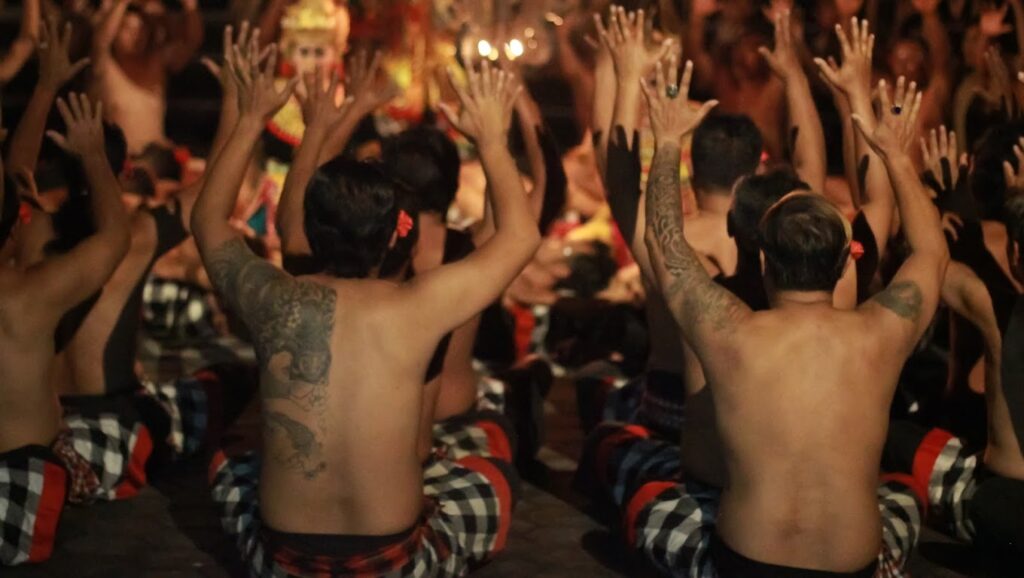The Kecak dance, also known as the “monkey chant dance,” is a form of Balinese dance and music drama that was developed in the 1930s in Bali, Indonesia. This unique and captivating dance is performed predominantly by a large group of male dancers who use their voices rather than musical instruments to provide the rhythm and melody of the performance. The dance is often accompanied by a gamelan suara, a choir of 50 to 100 men, who sit in concentric circles and chant “cak” and “kecak” in a rhythmic and hypnotic manner, giving the dance its name.
In the lush landscapes of Ubud, Bali, a captivating cultural spectacle known as the Kecak dance has held audiences spellbound for generations. Originating from the traditions of the island and deeply rooted in ancient mythology, the Kecak dance is a vibrant celebration of Balinese heritage. Through its rhythmic chanting, intricate choreography, and vivid storytelling, this traditional art form embodies the essence of Bali’s rich cultural tapestry.
Historical Roots and Cultural Context:
The roots of the Kecak dance can be traced back to the 1930s when the renowned German artist Walter Spies collaborated with the Balinese dancer Wayan Limbak to create a new form of performance art inspired by ancient trance rituals. Derived from traditional Balinese rituals, the Kecak dance found its unique identity through a fusion of storytelling, rhythmic chanting, and dramatic gestures, narrating episodes from the Hindu epic, Ramayana.
Embodying the spirit of communal harmony and collective spirit, the Kecak dance resonates deeply with Bali’s cultural ethos, emphasizing the significance of cooperation, unity, and spiritual devotion. Its evolution into a prominent cultural symbol of Ubud highlights the island’s commitment to preserving its traditional arts and sharing its rich cultural heritage with the world.

Ritualistic Chants and Expressive Movements:
At the heart of the Kecak dance lies its distinctive vocal element, where a chorus of over fifty male performers, seated in concentric circles, create a rhythmic and hypnotic soundscape with their repetitive “cak” chants. The interweaving patterns of these chants, mimicking the rhythmic patterns of traditional Balinese music, serve as the backdrop for the dramatic retelling of the Ramayana, wherein characters like Rama, Sita, and Hanuman come to life on the stage.
The dance unfolds with a mesmerizing display of intricate hand and body movements, symbolizing the epic battles, emotional conflicts, and triumphant victories depicted in the Ramayana. The performers, clad in traditional checkered cloth and adorned with elaborate ornaments, synchronize their gestures and expressions, creating a visually captivating narrative that transcends language barriers and cultural divides.
Cultural Continuity and Contemporary Significance:
Despite the influences of globalization and modernization, the Kecak dance remains a cultural cornerstone in Ubud, serving as a testament to Bali’s enduring commitment to preserving its cultural heritage. Cultural institutions, local communities, and performing arts centers actively engage in safeguarding the legacy of the Kecak dance, organizing regular performances, workshops, and educational programs to promote a deeper understanding of its historical and artistic significance.
The contemporary relevance of the Kecak dance extends beyond its role as a tourist attraction, serving as a bridge between the past and the present, and fostering intercultural dialogue and appreciation. By embracing modern innovations and incorporating diverse artistic interpretations, the Kecak dance continues to evolve while retaining its traditional essence, captivating audiences from across the globe and instilling a sense of wonder and appreciation for Bali’s cultural legacy.
Preservation Efforts and Global Outreach:
Through collaborative efforts between local communities, governmental initiatives, and international cultural exchanges, the preservation of the Kecak dance remains a top priority in Ubud. Various cultural festivals, educational workshops, and performance showcases are organized to raise awareness and promote the rich cultural heritage encapsulated within this traditional art form. The global outreach of the Kecak dance has not only contributed to the promotion of Balinese culture but has also fostered cross-cultural understanding, encouraging a shared appreciation for the diversity and richness of the world’s artistic traditions.
The Kecak dance of Ubud, Bali, embodies the spirit of communal harmony, artistic ingenuity, and cultural resilience, serving as a living testament to the island’s profound connection with its ancient traditions. Its rhythmic chants, expressive movements, and timeless narratives continue to captivate audiences, transcending geographical boundaries and fostering a deeper appreciation for Bali’s rich cultural legacy. As a symbol of collective spirit and artistic brilliance, the Kecak dance stands as a vibrant reminder of the enduring power of cultural heritage to inspire, unite, and enrich the human experience.
